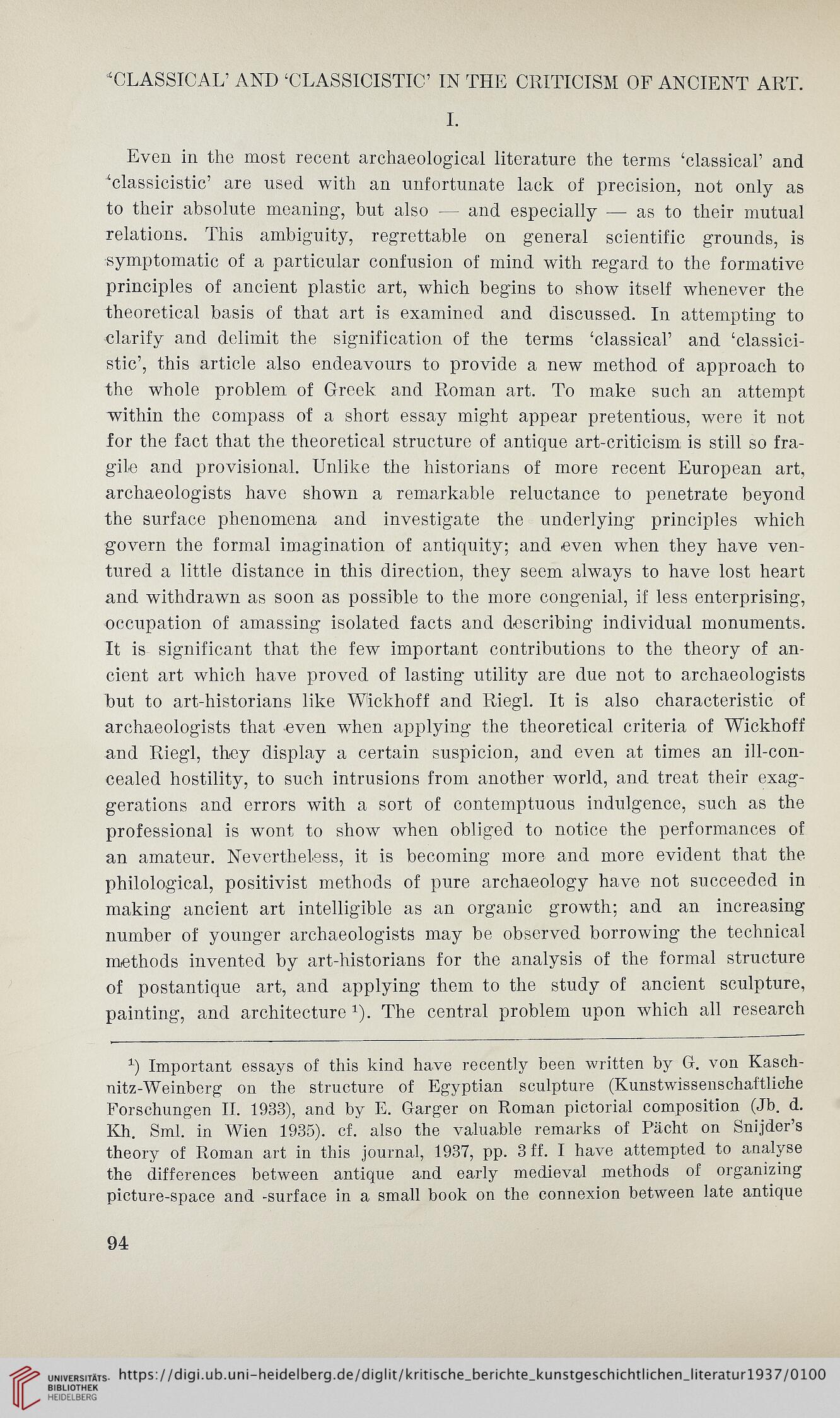'CLASSICAL' AND 'CLASSICISTIC' IN THE CRITICISM OF ANCIENT ART.
I.
Even in the most recent archaeological literature the terms 'classicah and
'classicistic' are used with an unfortunate lack of precision, not only as
to their absolute meaning, but also — and especially — as to their mutual
relations. This ambiguity, regrettable on general scientific grounds, is
symptomatic of a particular confusion of mind with regard to the formative
principles of ancient plastic art, which begins to show itself whenever the
theoretieal basis of that art is examined and discussed. In attempting to
clarify and delimit the signification of the terms 'classical' and 'classici-
stic', this article also endeavours to provide a new method of approach to
the whole problem of Greek and Roman art. To make such an attempt
within the compass of a short essay might appear pretentious, were it not
for the fact that the theoretieal structure of antique art-criticism is still so fra-
gile and provisional. Unlike the historians of more recent European art,
archaeologists have shown a remarkable reluctance to penetrate beyond
the surface phenomena and investigate the underlying principles which
govern the formal Imagination of antiquity; and even when they have ven-
tured a little distance in this direction, they seem always to have lost heart
and withdrawn as soon as possible to the more congenial, if less enterprising,
occupation of amassing isolated facts and describing individual monuments.
It is significant that the few important contributions to the theory of an-
cient art which have proved of lasting utility are due not to archaeologists
but to art-historians like Wickhoff and Riegl. It is also characteristic of
archaeologists that even when applying the theoretieal criteria of Wickhoff
and Riegl, they display a certain suspicion, and even at times an ill-con-
cealed hostility, to such intrusions from another world, and treat their exag-
gerations and errors with a sort of contemptuous indulgence, such as the
professional is wont to show when obliged to notice the performances of
an amateur. Nevertheless, it is becoming more and more evident that the
philological, positivist methods of pure archaeology have not succeeded in
making ancient art intelligible as an organic growth; and an increasing
number of younger archaeologists may be observed borrowing the technical
methods invented by art-historians for the analysis of the formal structure
of postantique art, and applying them to the study of ancient sculpture,
painting, and architecture 9. The central problem upon which all research
^ Important essays of this kind have recently been written by G. von Kasch-
nitz-Weinberg on the structure of Egyptian sculpture (Kunstwissenschaftliche
Forschungen II. 1933), and by E. Garger on Roman pictorial composition (Jb. d.
Kh. Sml. in Wien 1935). cf. also the valuable remarks of Pächt on Snijder's
theory of Roman art in this Journal, 1937, pp. 3 ff. I have attempted to analyse
the differences between antique and early medieval methods of organizing
picture-space and -surface in a small book on the connexion between late antique
94
I.
Even in the most recent archaeological literature the terms 'classicah and
'classicistic' are used with an unfortunate lack of precision, not only as
to their absolute meaning, but also — and especially — as to their mutual
relations. This ambiguity, regrettable on general scientific grounds, is
symptomatic of a particular confusion of mind with regard to the formative
principles of ancient plastic art, which begins to show itself whenever the
theoretieal basis of that art is examined and discussed. In attempting to
clarify and delimit the signification of the terms 'classical' and 'classici-
stic', this article also endeavours to provide a new method of approach to
the whole problem of Greek and Roman art. To make such an attempt
within the compass of a short essay might appear pretentious, were it not
for the fact that the theoretieal structure of antique art-criticism is still so fra-
gile and provisional. Unlike the historians of more recent European art,
archaeologists have shown a remarkable reluctance to penetrate beyond
the surface phenomena and investigate the underlying principles which
govern the formal Imagination of antiquity; and even when they have ven-
tured a little distance in this direction, they seem always to have lost heart
and withdrawn as soon as possible to the more congenial, if less enterprising,
occupation of amassing isolated facts and describing individual monuments.
It is significant that the few important contributions to the theory of an-
cient art which have proved of lasting utility are due not to archaeologists
but to art-historians like Wickhoff and Riegl. It is also characteristic of
archaeologists that even when applying the theoretieal criteria of Wickhoff
and Riegl, they display a certain suspicion, and even at times an ill-con-
cealed hostility, to such intrusions from another world, and treat their exag-
gerations and errors with a sort of contemptuous indulgence, such as the
professional is wont to show when obliged to notice the performances of
an amateur. Nevertheless, it is becoming more and more evident that the
philological, positivist methods of pure archaeology have not succeeded in
making ancient art intelligible as an organic growth; and an increasing
number of younger archaeologists may be observed borrowing the technical
methods invented by art-historians for the analysis of the formal structure
of postantique art, and applying them to the study of ancient sculpture,
painting, and architecture 9. The central problem upon which all research
^ Important essays of this kind have recently been written by G. von Kasch-
nitz-Weinberg on the structure of Egyptian sculpture (Kunstwissenschaftliche
Forschungen II. 1933), and by E. Garger on Roman pictorial composition (Jb. d.
Kh. Sml. in Wien 1935). cf. also the valuable remarks of Pächt on Snijder's
theory of Roman art in this Journal, 1937, pp. 3 ff. I have attempted to analyse
the differences between antique and early medieval methods of organizing
picture-space and -surface in a small book on the connexion between late antique
94




